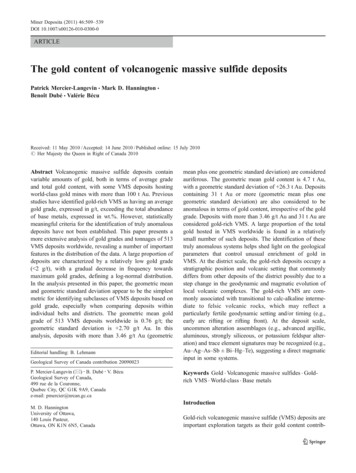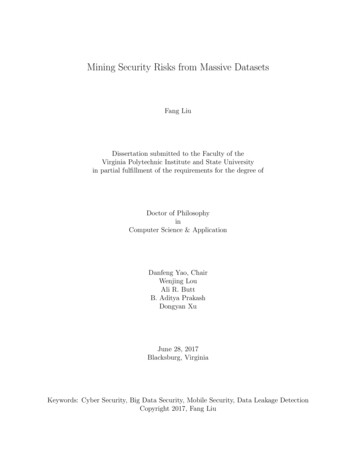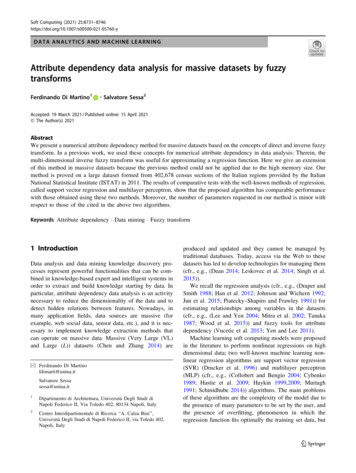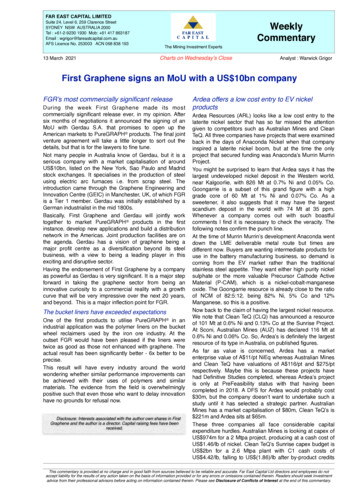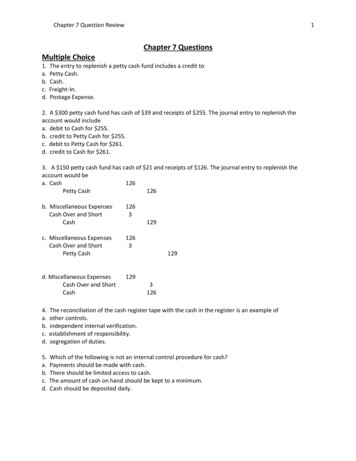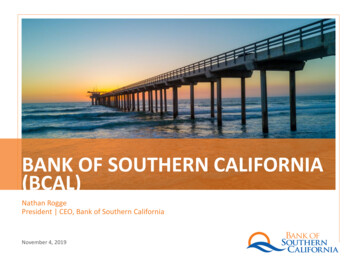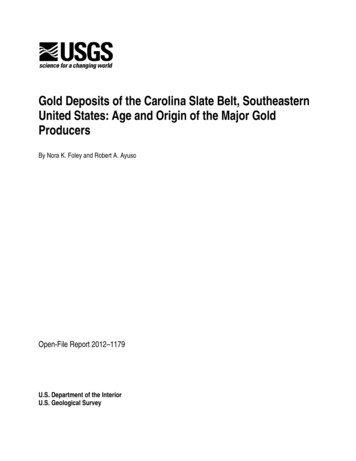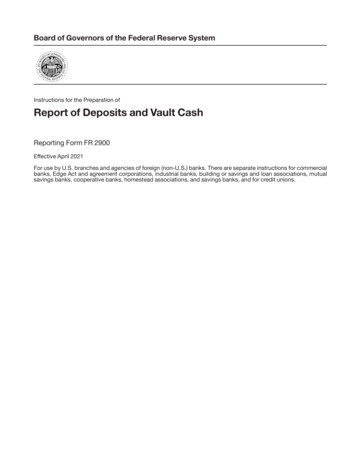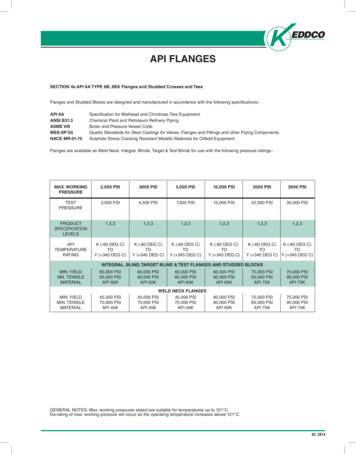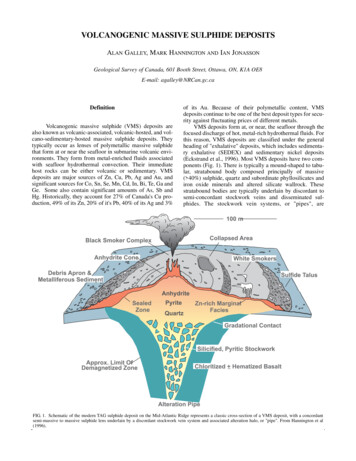
Transcription
VOLCANOGENIC MASSIVE SULPHIDE DEPOSITSALAN GALLEY, MARK HANNINGTON AND IAN JONASSONGeological Survey of Canada, 601 Booth Street, Ottawa, ON, K1A OE8E-mail: agalley@NRCan.gc.caDefinitionVolcanogenic massive sulphide (VMS) deposits arealso known as volcanic-associated, volcanic-hosted, and volcano-sedimentary-hosted massive sulphide deposits. Theytypically occur as lenses of polymetallic massive sulphidethat form at or near the seafloor in submarine volcanic environments. They form from metal-enriched fluids associatedwith seafloor hydrothermal convection. Their immediatehost rocks can be either volcanic or sedimentary. VMSdeposits are major sources of Zn, Cu, Pb, Ag and Au, andsignificant sources for Co, Sn, Se, Mn, Cd, In, Bi, Te, Ga andGe. Some also contain significant amounts of As, Sb andHg. Historically, they account for 27% of Canada's Cu production, 49% of its Zn, 20% of it's Pb, 40% of its Ag and 3%of its Au. Because of their polymetallic content, VMSdeposits continue to be one of the best deposit types for security against fluctuating prices of different metals.VMS deposits form at, or near, the seafloor through thefocused discharge of hot, metal-rich hydrothermal fluids. Forthis reason, VMS deposits are classified under the generalheading of "exhalative" deposits, which includes sedimentary exhalative (SEDEX) and sedimentary nickel deposits(Eckstrand et al., 1996). Most VMS deposits have two components (Fig. 1). There is typically a mound-shaped to tabular, stratabound body composed principally of massive( 40%) sulphide, quartz and subordinate phyllosilicates andiron oxide minerals and altered silicate wallrock. Thesestratabound bodies are typically underlain by discordant tosemi-concordant stockwork veins and disseminated sulphides. The stockwork vein systems, or "pipes", areFIG. 1. Schematic of the modern TAG sulphide deposit on the Mid-Atlantic Ridge represents a classic cross-section of a VMS deposit, with a concordantsemi-massive to massive sulphide lens underlain by a discordant stockwork vein system and associated alteration halo, or "pipe". From Hannington et al(1996).
Alan Galley, Mark Hannington and Ian Jonasson(1995) Au-rich VMS deposits are arbitrarily defined as thosein which the concentrations of Au in ppm is greater than thecombined base metals (Zn Cu Pb in wt. %: Fig. 3). A thirdclassification that is gaining popularity in Canada is a fivefold grouping suggested by Barrie and Hannington (1999) toindicate dominant host-rock lithology. Host-rock lithologiesinclude strata up to 3000m below the deposit and up to5000m along strike. The five groups are mafic-dominated,bimodal mafic, bimodal-felsic, siliciclastic-mafic, andbimodal-siliciclastic (Fig. 4). The order of this groupingreflects not only a progressive change from a less effusive toa more volcaniclastic-dominated environment, but also onein which felsic volcanic rocks become generally moreprominent. These lithological groupings generally correlatewith different tectonic settings. The groups associated withmafic volcanic and volcaniclastic strata are more common inoceanic arcs and spreading centers, whereas the two groupsdominated by felsic strata are more common in arc-continentmargin and continental arc regimes.Geographical DistributionFIG. 2. Base metal classification of worldwide and Canadian VMS depositsas defined first by Franklin et al. (1981) and modified by Large (1992) toinclude the Zn-Pb-Cu class. The preponderance of Cu-Zn and Zn-Cu VMSdeposits in Canada is due to the abundance of Precambrian primitiveoceanic arc settings. Worldwide there is a larger proportion of felsic-hosted, more Pb-rich continental and continent margin arc settings.enveloped in distinctive alteration halos, which may extendinto the hanging-wall strata above the VMS deposit.VMS deposits are grouped according to base metal content, gold content and host-rock lithology (Figs 2,3,4). Thebase metal classification used by Franklin et al. (1981) andrefined by Large (1992) is perhaps the most common. VMSdeposits are divided into Cu-Zn, Zn-Cu and Zn-Pb-Cugroups according to their contained ratios of these three metals (Fig 2). The Cu-Zn and Zn-Cu categories for Canadiandeposits were further refined by Morton and Franklin (1987)into Noranda and Mattabi types respectively, by includingthe character of their host rocks (mafic vs. felsic, effusive vs.volcaniclastic) and characteristic alteration mineral assemblages (chlorite-sericite-dominated vs. sericite-quartz carbonate-rich). The Zn-Pb-Cu category was added by Large(1992) in order to more fully represent the VMS deposits ofAustralia (Fig. 2). Poulsen and Hannington (1995) created asimple bimodal definition of "normal" vs. "Au-rich" VMSdeposits (Fig. 3). This originally was meant to identifydeposits that are transitional between VMS and epithermaldeposits (e.g., Sillitoe et al., 1996) (Fig 4). Further researchhas indicated a more complex spectrum of conditions for thegeneration of Au-rich VMS related to water depth, oxidationstate, the temperature of the metal-depositing fluids and possible magmatic contributions (e.g., Hannington et al.,1999a). In the classification of Poulsen and Hannington2There are close to 800 known VMS deposits worldwidewith geological reserves over 200,000 t. They are located insubmarine volcanic terranes that range in age from the 3.4Ga Archean Pilbara Block, Australia, to actively-formingdeposits in modern seafloor spreading and oceanic arc terranes (Fig. 5, Table 1). VMS-epithermal hybrids are alsoforming today in volcanically active shallow submarine(Manus Basin) and lacustrine environments. VMS depositsare recognized on every major continent except Antarctica,although Zn-Pb-Cu deposits are forming in Bransfield Straiton the Antarctic Peninsula (Peterson et al., 2004). Cu and Auhave been produced from Tertiary-age deposits hosted inophiolites around the eastern Mediterranean for over 5000years. Up to 2002, VMS deposits are estimated to have supplied over 5 billion t of sulphide ore (Franklin andFIG. 3. Classification of VMS deposits based on their relative proportionsof Cu Zn Pb versus precious metals (Au, Ag). Some of Canada's betterknown auriferous deposits (underlined) are compared to internationalexamples. Despite having produced 170 t of Au, the Flin Flon deposit is notconsidered an auriferous VMS deposit under this classification. Modifiedfrom Hannington et al. (1999c).
VMS SynthesisFIG. 4. Graphic representation of the lithological classification for VMS deposits by Barrie and Hannington (1999), with "high sulfidation" type an addedsubtype to the bimodal-felsic group. Average and median sizes for each type for all Canadian deposits, along with average grade.Hannington, 2002). This includes at least 22% of the world'sZn production, 6% of the world's Cu, 9.7% of the world's Pb,8.7% of it's Ag and 2.2% of it's Au (Singer, 1995).Over 350 deposits and major VMS occurrences containing geological reserves 200,000 t are known in Canada, ofwhich only 13 are presently producing mines (Figure 6,Table 2). Four of these will close in the next two years. VMSdeposits are known to occur in every province and territoryexcept Alberta and P.E.I. The largest number of deposits isin Quebec (33%), Manitoba (15%), Newfoundland (12%),British Columbia (10%), Ontario (9%), and New Brunswick(9%). The deposits in New Brunswick have had the highestaggregate metal value (Cu Zn Pb), followed by Quebec andthen Ontario (Fig. 7).Grade and TonnageThe 800 VMS deposits worldwide range in size from200,000 t to giant deposits. Among the largest is NevesCorvo in Spain's Iberian Pyrite Belt (IPB), with reserves inexcess of 270 Mt t, with 8.5 million t of contained metalshaving a value in 1999 of over 16 billion dollars (US) (Barrieand Hannington, 1999) (Fig. 8, 9a; Table 3). The entireIberian Pyrite Belt contains 88 deposits, with 7 over 100 Mt,containing an aggregate 1.575 billion tones of ore containing62.6 Mt Zn Cu Pb (Carvalho et al, 1999). The next largestdistricts are the Urals and Rudny-Altai of Russia andKazakhstan with over 70 Mt of contained metals each (Fig.5). Canada contains 4 giant VMS deposits (Windy Craggy,3
Alan Galley, Mark Hannington and Ian Jonassonbecause of its high Au/base metal ratio (Auppm/Zn Cu Pb% 1.9) it is classified by Agnico-EagleInc. as a gold deposit rather than a VMS deposit.Determining the mean and median metal concentrationsfor Canadian VMS deposits is difficult due to missing orincomplete data for a large number of deposits. Pb grades areknown for 34% of Canadian deposits, whereas 55% haveknown Au grades and 75% have known Ag grades. From theavailable production data, the mean and median (in brackets)size and grades for known Canadian deposits are 7 306 521t grading 4.88% (4.12) Zn, 1.62% (0.70) Cu, 1.639% (1.00)Pb, 63 g/t (37) Ag and 1.65 g/t (0.88) Au. Figure 9b showsthe more meaningful breakdown of tonnage and grade foreach of the five Canadian VMS types as defined by hostlithology. Bimodal-mafic deposits account for the greatestnumber and, therefore, the largest aggregate tonnage of thefive deposit types, with both siliciclastic types accountingfor the largest average tonnage. The mafic-siliciclasticdeposit types have the highest average tonnage, with thenumber highly skewed by Windy Craggy. As expected, thethree deposits types dominated by mafic volcanic and volcaniclastic rocks have the highest Cu grades, whereas thetwo felsic-dominated deposit types contain the highest Pband Ag. The bimodal-felsic deposit group contains the highest average gold. Mafic-ultramafic dominated systems canalso contain Se, Co and Ni. The presence of immature sediments within the footwall stratigraphy can also influencehydrothermal fluid composition, as is believed to be the casewith the Se-rich Wolverine and KZK deposits in theFinlayson Lake camp (Bradshaw et al., 2003). Possible contributions from devolatilizing subvolcanic intrusions mayalso account for anomalous concentrations of Se, Sn, In, Bi,Te, and possibly Au and Sb (Hannington et al., 1999c; Yangand Scott, 2003; Dubé et al., 2004).Geological AttributesBrunswick No. 12, Kidd Creek and Horne), which aredefined as being in the upper 1% of the world's VMSdeposits with respect to total original reserves (Fig. 10a). InCanada, the largest VMS mining district is Bathurst, NewBrunswick, which contained over 300 Mt of ore containing30 Mt of combined Zn, Cu and Pb (Fig. 6, 10a). The 128 MtBrunswick No. 12 deposit alone contained 16.4 Mt of metal(Table 1). This is followed by the 149.3 Mt Kidd Creekdeposit containing 12.6 Mt of metal. The largest knownCanadian VMS deposit is the 297 Mt Windy Craggy, but itonly contains 4.1 Mt of metals. The 50 Mt Horne depositcontains 2.2 Mt of Zn Cu Pb, along with over 330 t of Au,making it also a world-class gold deposit (Fig.10b). The 55Mt LaRonde VMS deposit contains 258 t of gold, and4Tectonic EnvironmentThe most common feature among all types of VMSdeposits is that they are formed in extensional tectonic settings, including both oceanic seafloor spreading and arcenvironments (Fig. 11). Modern seafloor VMS deposits arerecognized in both oceanic spreading ridge and arc environments (Herzig and Hannington, 1995), but deposits that arestill preserved in the geological record formed mainly inoceanic and continental nascent-arc, rifted arc and back-arcsettings (Allen et al. 2002; Franklin et al. 1998) (Fig. 11).This is because during subduction-driven tectonic activitymuch of the ancient ocean-floor is subducted, leaving only afew ophiolite suites as remnants of obducted ocean-floor.Examples of these may include the Ordovician Bay ofIslands ophiolite in Newfoundland and the Late TriassicCache Creek terrane in British Columbia (Bédard andHébert, 1996; Nelson and Mihalynuk, 2003).Nascent, or early arc rifting results from the initialfoundering of older thickened oceanic crust, commonlyalong transform fault sutures (Bloomer et al., 1995). Theseearly suprasubduction terranes are most commonly observedin the ancient rock record at the base of oceanic arc assemblages in which VMS deposits are spatially associated with
VMS SynthesisFIG. 5. Distribution of ancient and modern VMS deposits, with major districts highlighted with respect to known aggregate geological reserves. From GSCWorld Minerals Project.isolated extrusive rhyolite complexes near the top of thickbasalt and basaltic andesite successions. The best Canadianexample of these bimodal mafic dominated caldera settingsis the Paleoproterozoic host succession to the Anderson,Stall and Rod VMS deposits in the Snow Lake camp,Manitoba (Bailes and Galley, 1999). The komatiite-basaltrhyolite setting for the Archean Kidd Creek deposit is interpreted to be an early primitive arc setting possibly linked toan underlying mantle plume (Wyman et al., 1999), or a rareexample of a non-arc VMS setting associated with partiallithospheric melting above a mantle plume (cf. Iceland). TheNi-rich Potterdoal VMS deposit within the same KiddMunro komatiitic assemblage, is another rare example of akomatiite-associated VMS deposit (Epp and Crocket, 1999).In the idealized evolutionary stages of arc terrane formation, extension of the principal arc assemblage is anothercommon period of VMS formation (Fig. 11). This results inthe formation of calderas in which bimodal-mafic extrusivesuccessions predominate. This is perhaps the most commonarc environment for VMS formation in oceanic arc settings.Bimodal mafic-dominated VMS-hosting calderas includethe Archean Noranda and the Paleoproterozoic Flin Flonmining camps (Gibson and Watkinson, 1990; Syme andBailes, 1993). Rifting of continental margin arcs, in contrast,results in the development of more volcaniclastic-richbimodal-felsic extensional settings. Examples of this includethe Sturgeon Lake camp in the Archean Wabigoon terrane ofOntario (Morton et al., 1990; Whalen et al., 2004) and the5
Alan Galley, Mark Hannington and Ian Jonasson6
VMS SynthesisFIG. 6. Distribution of VMS deposits in Canada by geologic province. Numbers correspond to deposits listed in the national VMS database (Appendix 1).Devonian Buttle Lake VMS camp in the Wrangellia Terraneof BC (Barrett and Sherlock, 1996). Outside Canada, thePaleoproterozoic Skellefte mining district in Sweden(Weihed, 1996) and the Cambrian Mount Read VMS districtFIG. 7. Histogram of the total tonnage of base metals from known VMSdeposits per province, and the number of deposits the aggregate tonnagewas calculated from. Total metals represent original geological reserves.in Tasmania (Corbett, 1992) are other examples of riftedcontinental margin arc settings. Continued extension in bothoceanic and continental margin arc settings results in development of back-arc basins. In oceanic arc settings, matureback-arc ophiolites also can host VMS deposits. Canadianexamples include the Paleoproterozoic Birch-FlexarCoronation camp on the Saskatchewan side of the Flin Flonmining district (Wyman et al., 1999) and Betts Cove,Newfoundland (Swinden et al., 1988; Bedard et al., 1998).Well-known examples outside Canada include the Tethyanophiolites in Cyprus (Troodos), Oman (Semail) and Turkey(Ergani) (Galley and Koski, 1999, and references therein).Continental back-arc settings contain some of theworld's most economically important VMS districts. Theseenvironments are dominated by bimodal siliciclastic rocksiron formation and include the Ordovician Bathurst camp ofNew Brunswick (van Staal et al., 2003). Examples outsideCanada include the Archean Golden Grove camp in WesternAustralia (Sharpe and Gemmell, 2002), the PaleoproterozoicBergslagen district of Sweden (Allen et al., 1996), theCambro-Ordovician Mount Windsor district of Queensland7
Alan Galley, Mark Hannington and Ian Jonassonan accreted ocean-floor-arc assemblage can result in modification of the angle of descent of the subducting slab, cessation of subduction along a section of plate boundary, or achange in the direction of approach of the colliding plates(Ziegler, 1992; Hamilton, 1995). This process results in thegeneration of strike-slip basins in the older arc assemblages.Magmatism associated with these successor arc basins maybe associated with mineralized porphyry systems (Richards,2003), and the basins may be infilled with both subaqueousand subaerial bimodal volcanic rocks. This can result in theFIG. 8. Worldwide size distribution for VMS deposits, with deposits over50 Mt considered "giant", and those over 150 Mt considered "supergiant".Atlantis Deep is considered the largest modern example of a seafloor massive sulphide deposit, with Neves Corvo and Windy Craggy ancient examples of supergiant deposits. Modified from Hannington et al (1995).(Doyle and McPhie, 2000), the Devono-MississippianIberian Pyrite Belt (Carvalho et al, 1999), and parts of theDevonian Southern Urals VMS districts of Russia andKazakhstan (Herrington et al., 2002).Other extensional environments may form in postaccretion and/or successor arc settings. Crustal thickening ofFIG. 10. Distribution of Canadian VMS deposits with respect to aggregatebase metal grade versus tonnes (a) and contained Au versus long tonnes (b);most auriferous Au deposits contain 4 g/t Au (green diamonds). Thosecontaining over 1000 tonnes of Au (yellow diamonds) include both auriferous VMS deposits and those with moderate Au grades but large tonnages.Giant and supergiant VMS deposits are identified by name. From GSCCanadian VMS database.FIG. 9 statistics for VMS deposits grouped by lithologic class (Barrie andHannington, 1999): a) worldwide deposits; b) Canadian deposits groupedby lithologic class.8formation of multiple mineral deposit types, includingepithermal and VMS deposits. A good example of this is theLower Jurassic Hazelton Group in the Todogoone and Sustutregions of BC, the former containing the Eskay Creek Aurich VMS deposit (Barrett and Sherlock, 1996b, Nelson andMihalynuk, 2004). When these strike-slip fault systemspropagate into a continental margin setting, such as in themodern day Guaymas Basin, Gulf of California, the strikeslip basins begin to infill with terrigenous sediment. Theycan host mafic siliciclastic-hosted VMS deposits such as theTriassic Windy Craggy and Green's Creek deposits in BCand Alaska, respectively (Peter and Scott, 1999). These areknown as Besshi-type deposits from the type locality in thefore-deep accretionary wedge outboard of the Miocene
VMS SynthesisFIG. 11. There are three principal tectonic environments in which VMSdeposits form, each representing a stage in the formation of the earth'scrust. TOP: Early earth evolution was dominated by mantle plume activityduring which numerous incipient rift events formed basins characterizedby early ocean crust in the form of primitive basalts and/or komatiites, followed by siliciclastic infill and associated Fe-formation and mafic-ultramafic sills. In the Phanerozoic similar types of incipient rifts formed during transpressional, post accretion arc rifting (Windy Craggy). MIDDLE:The formation of true ocean basins was associated with the development ofocean spreading centers along which mafic-dominated VMS depositsformed. The development of subduction zones resulted in oceanic arc formation with associated extensional domains in which bimodal-mafic,bimodal-felsic and mafic-dominated VMS deposits formed. BOTTOM:The formation of mature arc and ocean-continent subduction fronts resulted in successor arc and continental volcanic arc assemblages that host mostof the felsic-dominated and bimodal siliciclastic deposits.underplate the crust, producing intermediate to felsic partialmelts and bimodal mafic intrusive/extrusive assemblages.The associated gabbro-diorite-tonalite-trondhjemite intrusive complexes may rise to within 2 to 3 km of the seafloor(Galley, 2003, and references therein). Where extension istaking place in thicker (20-30 km) crust, such as in a continental back-arc setting, magmas may form mid-crustal intrusions. These melts may not intrude into their comagmaticvolcanic assemblages but instead remain in the underlyingbasement rocks. These different scenarios result in variousforms of district-scale alteration and deposit characteristicsfor a VMS district.The presence of either mafic or composite high-levelsubvolcanic intrusions within a rift or caldera setting willdrive a sub-seafloor fluid convection system (Galley, 1993;Alt, 1995) (Fig 14). Connate seawater in the porous crust isfirst heated, causing it to become buoyant. As this heatedwater rises up synvolcanic fault structures, cold seawater isdrawn in above the cooling intrusion. These originally cold,neutral fluids are progressively heated during their downward migration, interacting with the surrounding rocks atprogressively higher temperatures. The isotherms abovecooling sill complexes are generally horizontal, resulting inthe formation of a stratified, district-scale semi-conformablealteration zone controlled in extent by the strike length of theunderlying intrusion (Spooner and Fyfe, 1973; Munha andKerrich, 1980; Lagerblad and Gorbatchev; 1985; Gibson andWatkinson, 1990; Galley, 1993; Alt, 1995; Brauhart et al.,1998; Bailes and Galley, 1999) (Fig.14). The distribution ofthe resulting alteration mineral assemblages mimic that ofregional metamorphic facies (Spooner and Fyfe, 1973, Alt,1995; Hannington et al., 2003) (Fig. 15). Hydrothermal fluidreaction zones immediately overlying the intrusions can bealtered to amphibolite facies assemblages, including Fe-Carich amphibole, clinozoisite, Ca-plagioclase, and magnetite(Fig. 15; Fig. 16a, b, c). Above this are Na-Ca-rich greenschist-facies assemblages characterized by albite, quartz,chlorite, actinolite and epidote. Closer to the seafloor areJapanese islands. Other mafic siliciclastic-hosted VMSdeposits occur along modern sedimented seafloor spreadingsystems such as Middle Valley, on the Juan de Fuca Ridgeoff the BC coast (Goodfellow et al., 1999).District-scale EnvironmentsMost, but not all significant VMS deposits occur in clusters that define major mining camps. Sangster (1980) usedthe distribution of VMS deposits within well-known miningdistricts in Canada to indicate that there was a first-orderregional control on their distribution (Fig. 12). In general,the deposit clusters are restricted to either linear rifts orcalderas. These features are generated by a regional thinningof the basement, depressurization of the underlying mantle,and generation of mafic magmas (Fig. 13). In ocean spreading-ridge settings these magmas rise to within a few thousand meters of the seafloor to form elongate gabbroic sillsthat parallel the seafloor spreading axes (Stinton andDetrick, 1992). Where pre-existing ocean-floor or arc lithosphere is present, these 1000 to 1400 C mafic magmas mayFIG. 12. A same-scale comparison of selected VMS districts. A 5 km diameter circle around each deposit shows the hypothetical area of influence ofproximal-scale alteration about each deposit, all encircled by a dashed linedefining the proposed extent of a regional-scale alteration system for eachcamp based on the presence of known felsic volcanic formations. In effect,the Noranda example corresponds closely to the observed alteration.Modified from Sangster (1980).9
Alan Galley, Mark Hannington and Ian Jonassonunderlying intrusion (Eastoe et al., 1987; Gibson andWatkinson, 1990; Brauhart et al., 1998; Galley, 2003). Faultsthat act as conduits for volcanic feeder systems tend to be thefocal point for ascent of high-temperature, metal-ladenhydrothermal fluids which form VMS deposits. These faultsystems may remain active through several cycles of volcanic and hydrothermal activity. The result is several periodsof VMS formation at different stratigraphic levels with a riftor caldera structure.Mafic-dominated, bimodal-mafic and bimodal-felsichost rocks are dominated by effusive volcanic successionsand accompanying, large-scale hypabyssal intrusions (Fig.17). This high-temperature sub-seafloor environment tendsto support high temperature ( 350 C) hydrothermal systems, which in turn can form Cu, Cu-Zn and Zn-Cu- (Pb)VMS deposits with variable Au and Ag contents. Areallyextensive, 1-5m thick Fe-rich "exhalites" may mark the mostprospective VMS horizons (Spry et al., 2000; Peter, 2003)(Fig. 16f, g). These exhalite deposits form from a combination of fine volcaniclastic material, chert and carbonate.FIG. 13. VMS environments are characterized by tectonic extension at various scales. Extension results in crustal thinning, mantle depressurizationand the generation of basaltic melts. Depending on crustal thickness anddensity, these mafic melts may pond at the base of the crust, resulting in partial melting and generation of granitoid melts. These anhydrous, high temperature melts may quickly rise to a sub-seafloor environment ( 3 kmbelow seafloor), where their heat may initiate and sustain convectivehydrothermal cells which form VMS deposits.zeolite-clay and related sub-greenschist mineral assemblagescharacterized by K-Mg-rich smectites, mixed layer chloritesand K-feldspar. Recognition of these chemical and mineralogical changes in the ancient rock record can be furtherenhanced by mapping shifts in bulk rock oxygen and hydrogen isotope compositions of the different zones (Green et al.,1983; Taylor and South, 1985; Aggerwal and Longstaffe,1987; Cathles, 1993; Paradis et al., 1993). These stratifiedalteration zones can have a strike length of 5 to 50 km and athickness of 1 to 3 km in caldera settings (Fig. 15). The sizeand areal morphology of the alteration system is a reflectionof the size and areal morphology of the VMS deposit cluster(Fig. 12). The distribution of VMS deposits within this cluster depends on synvolcanic fault distribution relative to the10FIG. 14. The development and maturation of a generic sub-seafloorhydrothermal system involves three stages: 1) Relatively deep emplacement of a subvolcanic intrusion below a rift/caldera and establishment of ashallow circulating, low temperature seawater convection system. Thisresults in shallow sub-seafloor alteration and associated formation of chemical sedimentation. 2) Higher level intrusion of subvolcanic magmas andresultant generation of a deep-seated sub-seafloor seawater convection system in which net gains and losses of elements are dictated by sub-horizontal isotherms. 3) Development of a mature, large-scale hydrothermal system in which subhorizontal isotherms control the formation of semi-conformable hydrothermal alteration assemblages. The high temperature reaction zone next to the cooling intrusion is periodically breached due to seismic activity or dike emplacement allowing focused upflow of metal-richfluids to the seafloor and formation of VMS deposits. From Galley (1993).
VMS SynthesisFIG. 15. Comparison of regional greenschist facies hydrothermal alterationin the Noranda Volcanic Complex with previously mapped metamorphicisograds (solid lines: from Dimroth et al. 1983; Powell et al., 1993). Thedistribution of greenschist facies hydrothermal alteration (shaded) suggeststhat interpreted metamorphic zonation is at least partly a product of earlysynvolcanic hydrothermal processes. Note that epidote and chlorite in thepre-cauldron sequence are distinct from those of the Mine Sequence volcanic rocks, even though they are well within the epidote-actinolite subfacies and have been metamorphosed at the same pressure and temperature.Modified from Hannington et al. (2003).They form during the immature and/or waning stages ofregional hydrothermal activity when shallowly circulatingseawater strips Fe, Si and some base metals at 250 C andprecipitates them on the seafloor through extensive, but diffuse, hydrothermal venting. Formation of exhalites on abasalt-dominated substrate is commonly accompanied bysilicification and/or chloritization of the underlying 200-500m of strata (Fig. 16d, e). Examples of this are observed in theNoranda, Matagami Lake, and Snow Lake VMS camps(Kalogeropoulos and Scott, 1983; Liaghat and MacLean,1992; Bailes and Galley, 1999). In felsic volcaniclastic-dominated terranes the generation of Fe-formation is accompanied by extensive K-Mg alteration of the felsic substrate, asrecorded in the Bergslagen district of Sweden (Lagerbladand Gorbatschev, 1985) and in the IPB (Munha and Kerrich,1980).Mafic, felsic, and bimodal siliciclastic volcanic assemblages tend to host volumetrically smaller mafic and/or felsic sill-dike complexes, and generally contain Zn-Cu-Co andZn-Pb-Cu-Ag VMS deposits, respectively. In deposit settings proximal to discrete extrusive complexes more Cu-richdeposits, such as Neves Corvo in the IPB, may also form.The district-scale semiconformable hydrothermal systemsconsist of low-temperature mineral assemblages, with Mg-Ksmectite and K-feldspar alteration and the formation ofextensive low-temperature Fe-Si-Mn deposits (i.e., a type ofiron formation). Other types of iron formation are interpreted to be products of plume fallout from high-temperaturehydrothermal venting in a reduced, stratified water column,or collection of hypersaline brines within fault-controlleddepressions on the seafloor (Peter, 2003). Individual units ofiron formation can extend for tens of km, as in the BathurstVMS camp in New Brunswick (Peter and Goodfellow,1996a), the Paleoproterozoic Bergslagen district (Allen etal., 1996), the Devono-Mississippian IPB in Spain andPortugal (Carvalho et al., 1999) and the MississippianFig. 16 A) High temperature hydrothermal alteration of mafic volcaniclastic turbidite overlain by a strongly silicified mafic debris flow 1200m belowthe Chisel-Lost-Ghost VMS horizon, Snow Lake. This represents a regional-scale reaction zone overlain by high temperature zone of silica dumping; B) Strongly silicified pillows with pipe vesicles infilled with actinolite,epidote and magnetite, and interpillow hyaloclastite completing replacedby the
state, the temperature of the metal-depositing fluids and pos-sible magmatic contributions (e.g., Hannington et al., 1999a). In the classification of Poulsen and Hannington (1995) Au-rich VMS deposits are arbitrarily defined as those in which the concentrations of Au in ppm is greater than the combined base metals (Zn Cu Pb in wt. %: Fig. 3). A .
